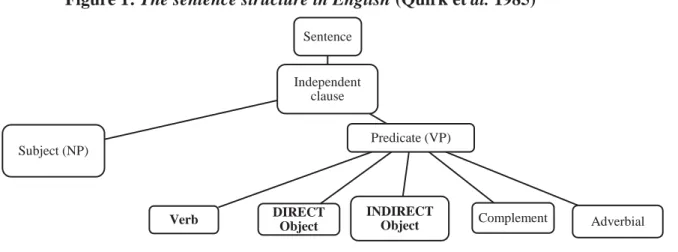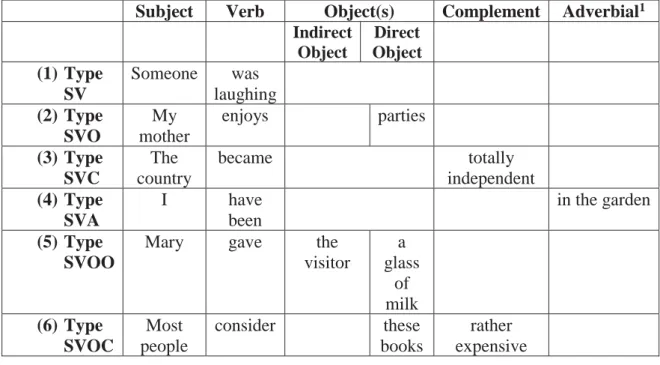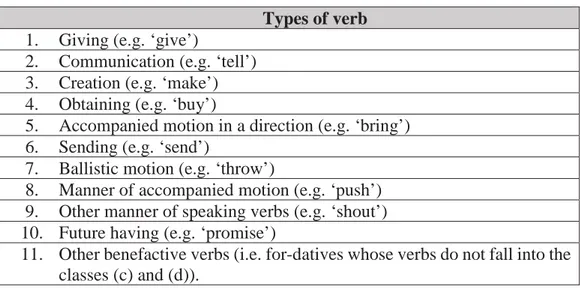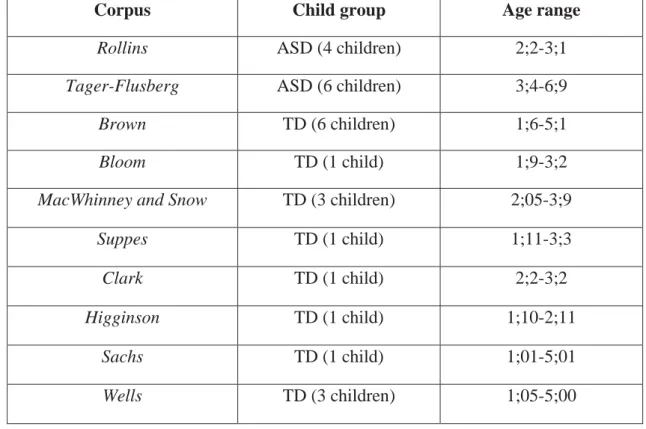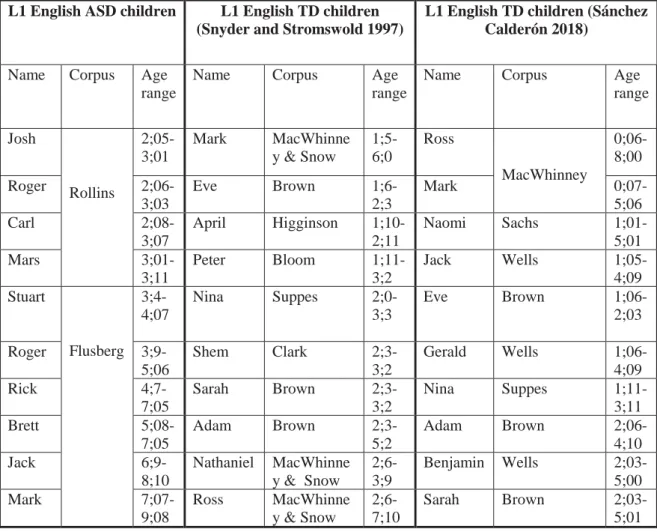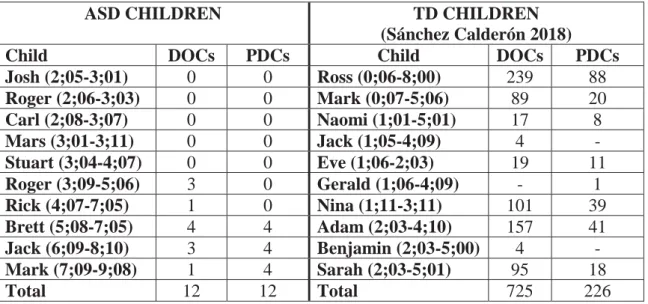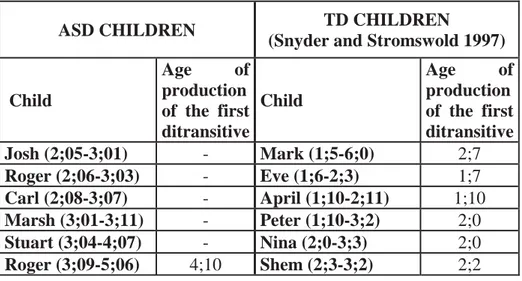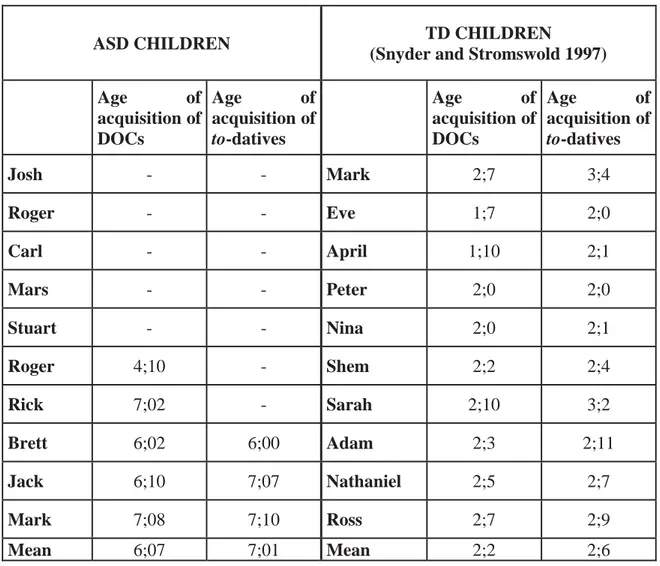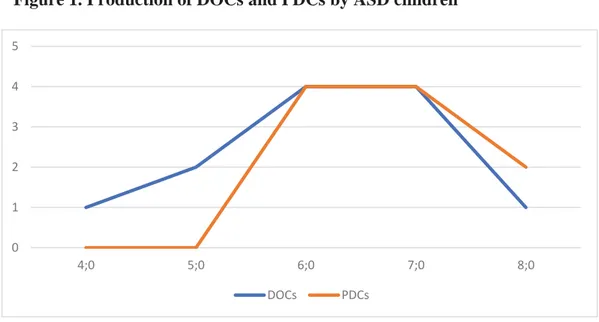FACULTAD de FILOSOFÍA Y LETRAS
DEPARTAMENTO de FILOLOGÍA INGLESA
Grado en Estudios Ingleses
TRABAJO DE FIN DE GRADO
INVESTIGATING HOW CHILDREN WITH AUTISM
DIFFER FROM TYPICALLY DEVELOPED CHILDREN:
THE ACQUISITION OF ENGLISH DITRANSITIVE
STRUCTURES
Sandra López Rodríguez
Tutor: Esther Álvarez de la Fuente
ABSTRACT
This undergraduate dissertation presents a grammatical study investigating the acquisition of ditransitive structures by English native speakers. Concretely, it compares the production of two child groups: typically developed children (TD) and children diagnosed with Autistic Spectrum Disorder (ASD). The analysis deals with the acquisition of ditransitive structures in different aspects: age of acquisition, acquisition of the different types of ditransitive structures and the different verbs these children use in semantic terms. The results of this study reveal that ASD children acquire ditransitive structures much later than TD children. However, both TD and ASD children acquire double object constructions (DOC) before prepositional dative constructions (PDC). Another similarity is that both child groups tend to use verbs from the “giving” semantic group when producing ditransitive structures.
KEYWORDS: ditransitive structures, dative, language acquisition, English native speakers, typically developed children, autistic spectrum disorder.
RESUMEN
Este trabajo de fin de grado ofrece una investigación sobre la adquisición de las estructuras ditransitivas por niños ingleses nativos. Concretamente, este estudio compara la producción de estas estructuras por niños de desarrollo típico con niños con autismo. El análisis aborda la adquisición de las estructuras ditransitivas desde varios enfoques: edad de adquisición, adquisición de los diferentes tipos de estructuras ditransitivas y los diferentes verbos usados por los participantes en términos semánticos. Los resultados de este estudio revelan que los niños con autismo adquieren las estructuras ditransitivas de manera tardía en comparación con los niños de desarrollo típico. Sin embargo, ambos grupos de niños adquieren antes las construcciones de doble objeto que las construcciones dativas con preposición. Otra similitud que comparten es el hecho de que ambos grupos tienden a usar verbos del grupo semántico del tipo “dar” cuando producen estructuras ditransitivas.
CONTENTS
1. Introduction ... 1
2. Theoretical background ... 2
2.1. Ditransitive structures in English: a syntactic approach... 5
2.2. Ditransitive structures in English: a semantic approach... 8
2.2.1. Types of ditransitive verbs... 8
2.2.2. Thematic roles in double object and prepositional object ditransitives... 9
3. Empirical background ... 10
3.1. Language acquisition in typically developed (TD) children ... 10
3.2. Language acquisition in children with Autism Spectrum Disorder (ASD) ... 12
3.3. Ditransitive structures in English language acquisition ... 14
4. Objectives ... 15
5. Methodology ... 16
5.1. Data selection ... 17
5.2. Participants ... 19
5.3. Data extraction ... 20
5.4. Discarded cases ... 21
6. Results ... 22
6.1. Research question 1: Do TD children and children with ASD differ in terms of the production of ditransitive structures?... 22
6.2. Research question 2: Is the order of acquisition of the different ditransitive structures similar in both groups of children?... 26
6.3. Research question 3: Will both groups differ in the semantic types of verbs produced?... 29
LIST OF ABREVIATIONS
ASD Autisim Spectrum Disorder
CHILDES CHIld Language Data Exchange System
CLAN Computerized Language Analysis
DO Direct Object
DOC Double Object Construction
IO Indirect Object
KWAL Key Word And Line
L1 First Language
MLU Mean Length of Utterance
NP Noun Phrase
PDC Prepositional Dative Construction
PP Prepositional Phrase
SV Subject - Verb
SVO Subject – Verb - Object
SVC Subject – Verb - Complement
SVA Subject – Verb - Adverbial
SVOO Subject – Verb – Object - Object
SVOC Subject – Verb – Object - Complement SVOA Subject – Verb – Object - Adverbial
1
1. INTRODUCTION
Language acquisition has been an important area of study in the recent decades. As it has been evidenced, there are two factors that are essential for the acquisition of any language and these are, firstly, the language faculty, which is genetically encoded (Chomsky 1981), that is, there is a system of principles available for each individual prior to experience and, secondly, interaction with other language users (i.e. input), which is required in order to fully acquire a language (Yule 1985). Moreover, there are extra factors that may affect language acquisition and therefore, the process of language acquisition will be altered. Specific language impairments are one of these extra factors that, in this case, are going to delay or alter language acquisition. In fact, this study contemplates one of these impairments, concretely Autistic Spectrum Disorder (ASD). This disorder affects children’s communication skills and speech production.
2 Finally, the production of ditransitive verbs is examined according to Gropen et al.’s (1989) semantic classification of these verbs.
This study is divided into different sections. The following section provides a brief and general theoretical background of the ditransitive structures from a syntactic and a semantic viewpoint. Section 3 shows an empirical background about some previous studies on TD and ASD children language acquisition, focusing on ditransitive structures. In the section 4, the objectives of the analysis are explained. Section 5 shows the methodology that has been used to carry out the study and section 6 includes the results and the discussion derived from this analysis. Finally, the conclusions reached by this study are collected in section 7.
2. THEORETICAL BACKGROUND
Sentences in English are frequently divided into two main components, i.e. noun phrase or NP (subject) and a verb phrase or VP (predicate). According to Quirk et al.
(1985), the verb element (V) is the most ‘central’ element, and it is usually preceded by the subject (S). Following the verb, there may be one or two objects (O), or a complement (C) which follows the object(s) if present. According to Quirk et al. (1985), the most peripheral element is the adverbial, which can occur either initially, or finally, as in Figure 1.
Figure 1: The sentence structure in English (Quirk et al. 1985)
Independent clause Sentence
Predicate (VP)
DIRECT Object
Verb INDIRECT Object Complement Adverbial
3 Of course, the order displayed in Figure 1 is not totally fixed. Although English is commonly described as a “fixed word-order language” (Quirk et al. 1985), there are cases in which certain elements undergo movement. In fact, Haegeman and Guéron (1999) state that one constituent can occupy different positions within a sentence. Moreover, they distinguish some types of movement as, for instance, the I-to-C movement which happens when an inflected verb is moved to the left of the subject of the subject in order to form a root interrogative. Since this work will deal with ditransitive structures, the different positions in which ditransitive elements can occur will be the one of the cases in which this study will be focused on.
A more recent approach on the English sentence structure from Haegeman and Guéron (1999) coincides with that from Quirk et al. (1985), shown in table 1, supporting that the VP is the semantic core of the sentence, that is, the verb as the central element of the sentence determines the number and types of arguments (i.e. S, O, C, A) that a sentence must contain:
Table 1. Types of sentences according to the syntactic structure
Subject Verb Object(s) Complement Adverbial1
Indirect Object Direct Object (1) Type SV
Someone was laughing
(2) Type SVO
My mother
enjoys parties
(3) Type SVC
The country
became totally
independent
(4) Type SVA
I have
been
in the garden
(5) Type SVOO
Mary gave the
visitor a glass of milk (6) Type SVOC Most people
consider these
books
rather expensive
4
(7) Type SVOA
You must put all the
toys
upstairs Adapted from Quirk et al. (1985:53)
According to the types of sentences shown in table 1, verbs can be divided into the following syntactic classification:
x Intransitive verbs (Type 1), are followed by no obligatory
element(s).
x Transitive verbs (Types 2, 6 and 7) are followed by an object and
Ditransitive verbs by two objects (Type 5).
o Monotransitive verbs occur in SVO structures.
o Complex transitive verbs2 occur in SVOC and SVOA structures.
x Copular verbs (SCV) and (SVA) are followed by a subject
complement or an adverbial.
(Quirk et al. 1985:53) In the following sections, a theoretical description focused on the ditransitive structures in English will be provided since this study is focused on Type 5 verbs, that is, ditransitive verbs, which not only differ from other transitive verbs types structurally (SVOO vs. SVO, SVOC, SVOA) but also semantically (Sánchez Calderón 2018): the indirect object and the direct object in ditransitive structures are associated with different thematic roles, i.e. beneficiary and theme, respectively, as examples (1) and (2) show:
(1) My mother enjoys parties MONOTRANSITIVE theme
(2) Mary gave the visitor a glass of milk DITRANSITIVE beneficiary theme
5 Therefore, this theoretical description is divided into two subsections. In section 1.1., ditransitive structures will be further described from a syntactic point of view showing the different verbs and arguments that may appear in a ditransitive structure. Thenceforth, in section 1.2., a brief description of ditransitive structures - from a semantic point of view - will present the thematic roles affecting ditransitive arguments.
2. 1. Ditransitive structures in English: a syntactic approach
It is already known that depending on the verb used in the sentence, the verb will require different arguments and, therefore it would have a different structure. For instance, a ditransitive verb requires two objects, direct and indirect object. This type of structure following a SVOO structure in contrast with a monotransitive verb that requires only one object and so it follows a SVO structure.
Following Huddleston (1984:245), out of the two types of objects, the direct object (DO) occurs in both monotransitive and ditransitive clauses, whereas the indirect object (IO) occurs only in ditransitives. The terms direct and indirect are based on the idea that in ditransitive clauses the DO argument is more directly affected by the verb than the IO argument.
More specifically, the ditransitive structures are those in which ‘someone is doing something for someone’. According to Haegeman and Guéron (1999), a ditransitive structure is the structure where both the direct and indirect object are compulsory. The lack of any of them would make the sentence to be ungrammatical, as the contrast of examples (3)-(5) show.
6 In example (3), both objects are present, being “Louise” the IO and “the draft” the direct object and therefore, the sentence is grammatical. However, in sentences (4) and (5) one of the objects, the DO or the IO, respectively, is missing, what makes both sentences ungrammatical (Haegeman and Guerón 1999).
This verb requires ‘something to be given, etc. to someone’ and this ‘someone’ is going to be the IO. The same happens in (9), in this case the DO is missing, and it makes the sentence ungrammatical as ‘something to be given to someone’ is needed. 3
Besides, according to Sánchez Calderón (2018), dative structures in English like that in (6a) and (6b) can also have an IO with a prepositional phrase form (PP) as shown in (6c) and (6d), respectively.
(6)
a) Mary told John the secret NP NP b) Mary bought John a book
NP NP c) Mary told the secret to John NP PP d) Mary bought a book for/to John4
NP PP
However, not all the ditranstive verbs allow the structure in (6b). This is the case of (8), where the verb ‘wish’ will not allow a PP construction.
3 It is possible to find objects known as “null objects” or “empty objects” as defined by Massam and Roberge (1989). This type of objects is possible because the object is recoverable from the context, as example (7) shows.
(7) He finally sent the letter
In (7) the null indirect object can be referring to someone mentioned previously in the context and who received “the letter”. However, as Haegueman and Guéron (1999) affirm, a null DO would be ungrammatical in this case as well.
7 (8)
a) They wished him good luck b)*They wished good luck to him
So, according to Malchukov et al. (2010), examples (6a), (6b) and (8a) are usually referred to as double object constructions (DOC), while examples (6c) and (6d) are referred to as to-dative constructions. Due to the presence of preposition to in these structures, they may be called as “prepositional dative constructions”. In fact, this study is going to address these constructions as PDCs.
There has been a discussion in literature concerning the relationship between DOCs and the PDCs (Baker 1979, Snyder and Stromswold 1997, among others). On the one hand, scholars like Baker (1979) have argued the existence of a phenomenon called “dative movement alternation”, which consists on the derivation of the PDC from the DOC, that is PDCs are the [NP PP] structures (as in examples (6c) and (6d)) resulting from the alternation of the [NP NP] structure of the DOCs (as in examples (6a) and (6b)). On the other hand, other scholars like Snyder and Stromswold (1997), based on their analysis, support that there is no derivational relationship between DOCs and PDCs as both constructions tend to emerge at the same age in children (DOCs at the age of 2;02 – PDCs at 2;06). In addition, Sánchez Calderón (2018) also considers that these structures are not derived from each other and therefore, there is the possibility that they are built from a shared underlying structure and so there is not a hierarchical relationship between them.
8 object NPs, whether they are pronouns or full NPs, whether they are discourse-given or not, and so on.”. In fact, this view point is along the same lines as those of Baker’s (1979) and Snyder and Stromswold’s (1997).
The previous studies (Snyder and Stromswold 1997, Sánchez Calderón 2018) have been focused on this discussion (i.e. what comes first, either DOCs or PDCs in language acquisition) but taking into account the monolingual or bilingual acquisition by typically developed children. The present study, however, will take into consideration a different type of participants (i.e. children with Autism Syndrome) which could shed light on this discussion as well.
2. 2. Ditransitive structures in English: a semantic approach
This section will provide a description of ditransitive structures from a semantic point of view. Hence, it is divided into two subsections. In subsection 2. 2. 1., there would be explained the different types of ditransitive verbs according to their meanings. Then, in 2. 2. 2., the thematic roles undergone by the DO and IO in ditransitive structures will be described.
2. 2. 1. Types of ditransitive verbs
9
Table 2. Types of verbs used in ditransitive structures (Gropen et al. 1989)
Types of verb
1. Giving (e.g. ‘give’)
2. Communication (e.g. ‘tell’) 3. Creation (e.g. ‘make’) 4. Obtaining (e.g. ‘buy’)
5. Accompanied motion in a direction (e.g. ‘bring’) 6. Sending (e.g. ‘send’)
7. Ballistic motion (e.g. ‘throw’)
8. Manner of accompanied motion (e.g. ‘push’) 9. Other manner of speaking verbs (e.g. ‘shout’) 10. Future having (e.g. ‘promise’)
11. Other benefactive verbs (i.e. for-datives whose verbs do not fall into the classes (c) and (d)).
This classification is going to be used as a point of reference to group the different ditransitive verbs found in this study and so, an evidence on what semantic types of verbs emerge first in the ditransitive acquisition by L1 English children will be provided. 5
2. 2. 2. Thematic roles in double object and prepositional object ditransitives
Objects in ditransitive structures can be semantically classified too. Malchukov et
al. (2010) supports that the objects in these constructions can be assigned different arguments depending on their semantics. The arguments present in a ditransitive sentence are the following: an agent argument, a recipient or beneficiary argument, and a theme argument (Haspelmath 2006). These roles are allocated both to DOCs and to PDCs as shown in (9) and (10), respectively.
(9) Thelma gave Louise the text. Agent Beneficiary Theme
/Recipient
(10) Thelma gave the text to Louise. Agent Theme Beneficiary /Recipient
10 In fact, Malchukoy et al.’s (2010) explanation follows the Uniformity of Theta Assignment Hypothesis (Baker 1988), according to which the subject is assigned a role as the agent, who is the one that is carrying out the action. Then, the recipient (or beneficiary) is the IO, as it is the one that the action is addressed to. Finally, the theme is the argument which undergoes the action, frequently an object and, it is syntactically classified as the DO. Besides, Quirk et al. (1985:1208) state that, according to the animacy of the objects, is the IO “is normally animated and positioned first” while the DO “is normally inanimate” which reinforces Malchukoy et al.’s (2010) explanation on how the different arguments are related to semantics.
As described in section 1, ditransitive structures have been deeply studied by many scholars who have provided a syntactic and/or semantic approach. Both of these viewpoints will be used in the present study to carry out an empirical research as explained in the following section.
3. EMPIRICAL BACKGROUND
The aim of this work is to establish a comparison between typically developed (TD) and autistic children (ASD) in order to determine whether they show the same linguistic behaviour in terms of how they produce different ditransitive structures. Concretely, this study is going to focus in the DOCs and PDCs.
Studying the acquisition of the first language (L1) in ASD children proves to be an interesting issue considering the relation with delay in their language development and the communication difficulties in their developmental disorders.
3. 1. Language acquisition in typically developed (TD) children
11 circumstances, and in a limited amount of time, in identical ways across different languages”. By following this quotation, it can be deduced that there is an innate predisposition towards language in children. Moreover, it should be taken into account that there are two important factors in which language acquisition is also based. Firstly, there is the so-called Universal Grammar, which is “some system of principles, common to the species and available to each individual prior to experience” (Chomsky 1981:7). Another element that is required for language acquisition is the input, which consists of the interaction with other people, that is, children need to receive linguistic production from other people in order to be able to generate their own linguistic production. As discussed later, any of these elements can be impaired and therefore, it may provoke a delay in the language acquisition. By following the steps of TD children, during the first year, children find themselves in the pre-language stage, which is composed by cooing, babbling and later babbling. These sounds produced by children are usually a response when interacting with adults. From the first year of life, children find themselves into the language stage. Some other phases can be distinguished during this age range according to Yule (2006):
x Holophrastic or one-word stage (12-18 months): children produce simple terms
for everyday objects and single forms functioning as a phrase or a sentence.
x Two-word stage (18-20 months): children produce beyond 50 distinct vocabulary
words produced by the child.
x Telegraphic speech (21-24 months): children produce strings of lexical
12
x Multiple-word speech (2 to 3 years): children produce 200 to 400 distinct words,
but they can understand five times as many. In this phase, the salient property of these utterances ceases to be the number of words but the variation in word-forms and the use of inflectional morphemes.
This classification of the different stages up to the age of 3 in L1 acquisition will be a referent to classify the production of the child participants of our study as most L1 TD English children start producing dative structures before the age of 3 as proved by Snyder and Stromswold (1997).
Nevertheless, all children do not follow the same stages when acquiring a language. There are going to be some cases in which children undergo linguistic delays and they have several manifestations due to certain linguistic impairments, ASD being one of them, as presented in the following section.
3. 2. Language acquisition in children with Autism Spectrum Disorder (ASD)
According to Guasti (2002), children that undergo linguistic disorders are diagnosed with specific language impairment (SLI). These children have a dissociation between their linguistic abilities and other abilities. Some of the indicators of SLI are the following: language emerges later, language may show unexpected patterns and remains below age expectations and the affected individual may exhibit problems with inflectional morphology.
13 (classic autism), Asperger’s Disorder (Asperger syndrome), Pervasive Developmental Disorder not otherwise specified, Childhood Disintegrative Disorder and Rett’s Disorder. Although some of the characteristics that they present are social and communicative dysfunctions, delay in speech acquisition (except in Asperger´s disorder) and reiterative behavior, they can be alleviated with special education programs and behavior therapy.
As for the language dysfunctions in ASD children, following Simon (1975), autistic children do not develop normally. Based on her observations of two children, she argues that autistic children do not show gradual growth in their mean length of utterance or the same order of emergence of grammatical structures that are among the hallmarks of normally developing language children. In addition, related with linguistic dysfunctions, Muma (2010) states that ASD children verbal productions are different from those in TD children as there is are delays or difficulties with the production of language.
In section 2.1., it was mentioned that, according to Guasti (2002:2), during the first year of life, children produce sounds like a response to adults’ interaction. However, there may be impairment in the language of children with ASD since they are one-year-old as it is supported by Muma (2010), who distinguishes the reaction of TD and ASD children in a dialogue. While TD children usually react to dialogue by producing a stream of vocal play, ASD children may not take reciprocal part in the dialogue. So, it can be inferred following Muma’s prediction (2010) that it is probable that if ASD children do not behave linguistically speaking as their TD counterparts in their first language stage, they will lag behind in the following stages.
14 the production of complex structures, as ditransitive structures, are acquired in a different way in comparison with TD children.
3. 3. Ditransitive structures in English language acquisition
Several scholars have carried out research on how L1 English children acquire ditransitive structures, for instance, Snyder and Stromswold (1997) and Sánchez Calderón (2018). In order to conduct their study, Snyder and Stromswold analyzed computerized transcripts of 12 children's spontaneous speech. The children ranged in age from 1 year, 4 months (1;4) to 7 years and the main aim of their study was to discern when different ditransitive structures such as DOCs or PDCs are acquired by L1 English TD children. The results of their research support that children acquire double object datives from 1;8 to 2; 11 while PDCs or, more specifically, to-datives are acquired from 2;0 to 3;4 and so, later than DOCs. The temporal gap between the acquisition of these two structures goes from 0 months to 12 months. The conclusion derived from this study is that as the L1 English children study acquired DOCs earlier, they seem to be easier than prepositional datives, which were acquired later.
Similar findings were found in the research carried out by Sánchez Calderón (2018), who pointed out that in the case of the L1 English children of her study DOCs were acquired earlier than to/for-datives, being the mean age 2;02 and 2;06 respectively in line with the results found in Snyder and Stromswold’s (1997) and Sánchez Calderón also supporting the fact that to/for-datives are acquired later than DOCs.
15 ditransitive structures and how they differ from the TD children participants of previous studies (Snyder and Stromswold 1997, Sánchez Calderón 2018).
4. OBJECTIVES
According to the Centers for Disease Control and Prevention (CDC) diagnosticated cases of children with ASD have increased in the last years. Children with autism represents the 15% percent of children in the United States. Now, there is one child with ASD in 59 from one child with ASD in 68 children that were two years before. For this reason, I think is so important to investigate this disorder in an essential area as it is language acquisition. Nowadays, there are scarce studies dealing with language acquisition in SLI (specific language impairment) children), especially in children with ASD, as far as we know, which makes our dissertation an innovative study in the language acquisition field. Concretely, this dissertation deals with the production of ditransitive structures by both TD children and children with ASD from 1 to 7 years-old. Bearing it in mind and, in order to observe if there is any difference between the acquisition of ditransitive structures by L1 English TD and ASD children throughout their language development, the following three research questions are proposed:
Research question 1: Do TD children and children with ASD differ in terms of the
production of ditransitive structures?
16
Research question 2: Is the order of acquisition of the different ditransitive
structures similar in both group of children?
As pointed out in section 3. 3., it seems that L1 English TD children acquire DOCs earlier than PDCs (Snyder and Stromswold 1997, Sánchez Calderón 2018). It is the purpose of the present study to attest if children with ASD follow the same pattern, that is, if they produce DOCs earlier than PDCs, as L1 TD children do. Also, it will be analyzed if there is any tendency in both groups of children to produce one structure more than the other.
Research question 3: Will both groups differ in the semantic types of verbs
produced?
As explained in section 1.2., following Pinker’s (1989) and Gropen et al.’s (1989) classification of ditransitive verbs according to semantic criteria, we intend to find out if both TD children and children with ASD present any differences acquiring and producing different semantic types of ditransitive verbs.
In order to reach an answer to these three research questions, it is necessary to carry out an analysis of the ditransitive structures produced by a group of L1 English ASD children. The procedure used in this analysis is explained in the following section.
5. METHODOLOGY
17 information about the participants is provided and finally, in section 4. 3. the procedure followed during the data extraction and classification is explained.
5. 1. Data selection
The data used to carry out this dissertation has been extracted from the CHILDES project (MacWhinney 2000). CHILDES is a database made up of transcripts of mostly oral production by monolingual and bilingual children in diverse languages. Lately, CHILDES has become a component of the corpus TalkBank and therefore, it now includes wider data as, for instance, the oral production of SLI speakers which have different language disorders such as aphasia or autism.
The data used in this dissertation has been extracted from two different corpora and from Snyder and Stromswold’s (1997) and Sánchez Calderón’s (2018) analyses (several children from Brown, Bloom, MacWhinney and Snow, Suppes, Clark, Higginson,
Sachs and Wells). A more detailed description of the data used are illustrated in table 3.
Table 3. Corpora information
Corpus Child group Age range
Rollins ASD (4 children) 2;2-3;1
Tager-Flusberg ASD (6 children) 3;4-6;9
Brown TD (6 children) 1;6-5;1
Bloom TD (1 child) 1;9-3;2
MacWhinney and Snow TD (3 children) 2;05-3;9
Suppes TD (1 child) 1;11-3;3
Clark TD (1 child) 2;2-3;2
Higginson TD (1 child) 1;10-2;11
Sachs TD (1 child) 1;01-5;01
18 As seen in table 3, the Clinical/Language Disorders folder has been used for extracting transcripts from children with ASD corpora. More specifically, the corpora selected were from the Rollins Corpus and the Tager-Flusberg Corpus: ASD. The Rollins Corpus was compiled to study the pragmatic accomplishments and vocabulary development in pre-school children with autism. It is made up of 21 files of 5 children with ASD between the age of 2;2 and 3;1, although only 4 have been analyzed (those whose age matches closer to that of monolinguals). The data in this corpus are spontaneous and include recordings of one-on-one conversations with a clinician. Then, the Tager-Flusberg Corpus was created to study language acquisition in autistic and Down syndrome children. The section of the corpus that deals with autistic children is made up of 64 files of 6 children with ASD between the age of 3;4 and 6;9. The data in this corpus are spontaneous and recorded in the familiar social context. Both corpora have been recorded in the United States so, the variety of English used is American English.
19
5. 2. Participants
As one of the main aims of this study is to discover at what age TD and ASD children acquire dative structures, participants have been selected according to their age and not to their MLU, following Snyder and Stromswold’s (1997) criterion.
Table 4. Age-matched TD and ASD children participants
As observed in table 4, in the case of ASD children and with the aim of covering a wider range of age, the production of 4 participants from Rollins Corpus and that of the 6 participants of Tager-Flusberg Corpus: ASD are analyzed in this dissertation. However, only ten participants out of the twelve analyzed in Snyder and Stromswold (1997) and only ten participants out of the thirteen analyzed in Sánchez Calderón (2018) were
L1 English ASD children L1 English TD children (Snyder and Stromswold 1997)
L1 English TD children (Sánchez Calderón 2018)
Name Corpus Age
range
Name Corpus Age
range
Name Corpus Age
range
Josh
Rollins
2;05-3;01
Mark MacWhinne
y & Snow
1;5-6;0 Ross MacWhinney 0;06-8;00
Roger
2;06-3;03
Eve Brown
1;6-2;3
Mark
0;07-5;06
Carl
2;08-3;07
April Higginson
1;10-2;11
Naomi Sachs
1;01-5;01
Mars
3;01-3;11
Peter Bloom
1;11-3;2
Jack Wells
1;05-4;09 Stuart
Flusberg 3;4-4;07
Nina Suppes
2;0-3;3
Eve Brown
1;06-2;03
Roger
3;9-5;06
Shem Clark
2;3-3;2
Gerald Wells
1;06-4;09
Rick
4;7-7;05
Sarah Brown
2;3-3;2
Nina Suppes
1;11-3;11
Brett
5;08-7;05
Adam Brown
2;3-5;2
Adam Brown
2;06-4;10
Jack
6;9-8;10
Nathaniel MacWhinne
y & Snow
2;6-3;9
Benjamin Wells
2;03-5;00
Mark
7;07-9;08
Ross MacWhinne
y & Snow
2;6-7;10
Sarah Brown
20 selected for the comparison following the criterion of age: that is, we selected those L1 English TD children whose age is closer to that of the L1 English ASD children. Moreover, Snyder and Stromswold (1997) and Sánchez Calderón (2018) coincide with some of the participants that have analyzed in their respective studies.
The criteria followed to select the participants has been based on the following prerequisites: (a) the participants have English as their L1, (b) the selected number of TD children and children with ASD are balanced, (c) the age range of the L1 English TD children when possible should fall within the age range of L1 English ASD children. 6
Bearing in mind these criteria, the data that have been analyzed have been extracted following different processes.
5. 3. Data extraction
One of the main aims of this study is to find out the age of acquisition of ditransitive structures in children with ASD. Stromswold (1988, 1989) supports that there is a correlation between the age of the first use and the acquisition. Therefore, the first time a child produces a ditransitive structure in an adult-like form, it is going to be considered the age of acquisition of ditransitive structures.
In order to discover this age of acquisition, the CLAN program has been used to analyze the data. The programs from this tool that were used are FREQ and KWAL. In order to find occurrences of DOCs, the program FREQ has been used combined with manual extraction. FREQ gives you the number of times an item appears in a file. The syntax line used for carrying out this analysis was freq + t*CHI +s”verb”@. Therefore, a list of ditransitive verbs has been created in order to look for occurrences of these verbs
21 in the files. Moreover, in order to find to-datives, FREQ has been used to locate all the lines containing the word to. After this localization process, a manual extraction was performed in order to check out if any of the structures had been missing. Finally, KWAL has been used in order to determine the context where the item is produced (i.e. the previous and following lines).
Nevertheless, the methodology followed has a small level of noise. Manual extraction was necessary when discarding some of the structures found by these two programs.
5. 4. Discarded cases
After the data extraction process, there were some instances that did not follow the criteria established for the analysis. Therefore, these instances have been discarded. In this subsection, some of these instances that have been discarded are provided with an explanation of why they do not follow the criteria of selection.
As mentioned in section 2. 2., one of the main characteristics of ASD children is repetitive speech. Therefore, there are some cases in which ASD children produce ditransitive structures as a consequence of imitating all or part of their interlocutors’ utterances as shown in (11).
(11) *MOT: because the doctor gave them to you .
*CHI: because the doctor gave them to me .
22 when they produce a sentence following orders as in (12), where a partial repetition is also reproduced:
(12) *MOT: say , give the crayon . *CHI: give me a crayon .
[Roger 5;00, Flusberg Corpus] Once all the methodology followed in the analysis is explained, in the following section the results obtained are presented.
6. RESULTS
In this section, the results obtained from the analysis are provided. It is divided into four different subsections, that correspond with each of the research questions put forward in section 4: 1) the differences between TD and ASD children in terms of ditransitive production is presented; 2) the production of different ditransitive structures, DOCs and to-datives, by TD and ASD children; and 3) the production of these structures by both groups of children according to the semantic types of ditransitive verbs and finally, a general discussion dealing with the results obtained.
6. 1. Research question 1: Do TD children and children with ASD differ in terms of
the production of ditransitive structures?
23
Table 5. Number of adult-like ditransitive structures produced by ASD
children in comparison with TD children
ASD CHILDREN TD CHILDREN
(Sánchez Calderón 2018)
Child DOCs PDCs Child DOCs PDCs
Josh (2;05-3;01) 0 0 Ross (0;06-8;00) 239 88
Roger (2;06-3;03) 0 0 Mark (0;07-5;06) 89 20
Carl (2;08-3;07) 0 0 Naomi (1;01-5;01) 17 8
Mars (3;01-3;11) 0 0 Jack (1;05-4;09) 4 -
Stuart (3;04-4;07) 0 0 Eve (1;06-2;03) 19 11
Roger (3;09-5;06) 3 0 Gerald (1;06-4;09) - 1
Rick (4;07-7;05) 1 0 Nina (1;11-3;11) 101 39
Brett (5;08-7;05) 4 4 Adam (2;03-4;10) 157 41
Jack (6;09-8;10) 3 4 Benjamin (2;03-5;00) 4 -
Mark (7;09-9;08) 1 4 Sarah (2;03-5;01) 95 18
Total 12 12 Total 725 226
There is a huge difference between the number of times TD and ASD children produce ditransitive structures (DOCs 12 vs 725; PDCs 12 vs 226). As shown in table 5, ASD children scarcely produce ditransitive structures. Therefore, TD children use dative structures at a higher rate than ASD children. The difficulty ASD children have producing a complete ditransitive structure can be appreciated in (19).
(19) *MOT: what is she giving ?
*CHI: umbrella .
*MOT: you tell me , full sentence .
*CHI: giving umbrella .
*MOT: who’s giving umbrella ? *CHI: who’s giving ?
*MOT: no , who’s giving ?
*CHI: him give umbrella .
*MOT: who gives , the mo [/?] +/.
*CHI: mommy give umbrella
*MOT: right .
*MOT: let’s write it down .
*CHI: mommy give +/.
*MOT: the mommy +/.
*CHI: gives .
*MOT: gives +/.
*CHI: the umbrella .
*MOT: to whom ?
*MOT: who does she give the umbrella to ?
24 *MOT: to the cat +/.
*CHI: no .
*CHI: yes .
*CHI: no .
*MOT: no .
*MOT: who is she giving it to ?
*CHI: boy .
*CHI: mommy .
*MOT: mommy is giving the umbrella to who ?
*MOT: to the dog .
*CHI: yes .
[Mark 8;02, Flusberg Corpus] At the same time, children with ASD tend to talk less in general terms than TD children. According to Yule (2006) (see section 3), TD children between two and three years-old produce a multiple-word speech. However, ASD children analyzed between these ages (Carl, Josh, Mars, Roger and even Stuart) have shown a very repetitive speech, only composed by one or two word per sentence and characterized by being a very repetitive speech. Therefore, it is confirmed that TD children are more linguistic developed than ASD children in linguistic terms and concretely in terms of ditransitive structures production.
As for the age of acquisition of ditransitive structures in both groups of children, the results are shown in table 6.
Table 6. Age of acquisition of ditransitive structures in ASD children
compared to TD children
ASD CHILDREN TD CHILDREN
(Snyder and Stromswold 1997)
Child
Age of production of the first ditransitive
Child
Age of production of the first ditransitive Josh (2;05-3;01) - Mark (1;5-6;0) 2;7
Roger (2;06-3;03) - Eve (1;6-2;3) 1;7
Carl (2;08-3;07) - April (1;10-2;11) 1;10
Marsh (3;01-3;11) - Peter (1;10-3;2) 2;0
Stuart (3;04-4;07) - Nina (2;0-3;3) 2;0
25 As shown in table 6, a great amount of ASD children (5 out of 10) did not produce ditransitive structures between the ages they were recorded. However, according to how old they were in the last session recorded, it is obvious that they would acquire dative structures after their age in their last recording. For instance, Stuart has been recorded until 4;07 but he has not produced any ditransitive structure yet. Therefore, Stuart will acquire ditransitive structures later than 4;07.
By comparing the results of TD and ASD children, it is proved that there is huge difference between the ditransitive structures production of TD and ASD children. So, while TD children acquire ditransitive structures when they are in the multiple-word speech stage, 2 to 3 years (Yule 2006), ASD children acquire both of them much later (4;10-7;08) and therefore, they cannot be classified according to Yule’s (2006) classification.
Finally, in order to take into account all the ditransitive structures produced derived from our analysis, table 7 shows the percentage of non-adult like ditransitive structures produced by each ASD child.
Table 7. Frequency of non-adult like dative structures produced by ASD
children 7
Child # ditransitive structures produced
# non-adult dative structures produced
Josh (2;05-3;01) 0 -
Roger (2;06-3;03) 0 -
7 The results of these non-adult like structures cannot be compared with those produced by the TD children as they were not available in Snyder & Stromswold (1997)’s analysis.
Rick (4;07-7;05) 7;02 Sarah (2;3-5;1) 2;10
Brett (5;08-7;05) 6;00 Adam (2;3-5;2) 2;3
Jack (6;09-8;10) 6;10 Nathaniel (2;6-3;9) 2;5
Mark (7;09-9;08) 7;08 Ross (2;6-7;10) 2;7
26
Carl (2;08-3;07) 0 -
Marsh (3;01-3;11) 0 -
Stuart (3;04-4;07) 0 -
Roger (3;09-5;06) 3 0
Rick (4;07-7;05) 6 5
Brett (5;08-7;05) 11 3
Jack (6;09-8;10) 10 3
Mark (7;09-9;08) 5 0
It should be mentioned that, according to the information in table 7, most of the non-adult ditrasitives (31%) were produced before they produce an adult-like ditransitive structure for the first time. Therefore, the hypothesis supported by Stromswold (1988, 1989) of the correlation between the age of the first use and the age of acquisition is confirmed. When these children have a ditransitive structure in an adult-like way, they do not tend to make mistakes producing these structures anymore.
6. 2. Research question 2: Is the order of acquisition of the different ditransitive
structures similar in both group of children?
It seems that L1 English TD children have more ease producing DOCs than PDCs, a result that is in line with those of Snyder and Stromswold’s (1997) and Sánchez Calderón’s (2018).
27
Table 8. Age of acquisition of ditransitive structures by ASD and TD
children.
ASD CHILDREN TD CHILDREN
(Snyder and Stromswold 1997)
Age of acquisition of
DOCs
Age of acquisition of
to-datives
Age of acquisition of
DOCs
Age of acquisition of
to-datives
Josh - - Mark 2;7 3;4
Roger - - Eve 1;7 2;0
Carl - - April 1;10 2;1
Mars - - Peter 2;0 2;0
Stuart - - Nina 2;0 2;1
Roger 4;10 - Shem 2;2 2;4
Rick 7;02 - Sarah 2;10 3;2
Brett 6;02 6;00 Adam 2;3 2;11
Jack 6;10 7;07 Nathaniel 2;5 2;7
Mark 7;08 7;10 Ross 2;7 2;9
Mean 6;07 7;01 Mean 2;2 2;6
As shown in table 8, the age of acquisition of DOCs by ASD children ranges from 4;10 to 7;08 (mean=6;07) and from 6;00 to 7;10 for to-datives (mean=7;01). There is a temporal gap of two years and ten months for DOCs and one year and ten months for
to-datives8. Four of the ten children (Jack, Mark, Rick and Roger) acquired DOCs before
to-datives while only one child (Brett) acquired to-datives before DOCs and the temporal gap between the acquisition of these structures is of only two months.
28 As for TD children (Snyder and Stromswold 1997), the age of acquisition ranged from 1;8 to 2; 11 for DOCs (mean=2;2) and from 2;0 to 3;4 for to-datives (mean=2;6). Nine of the ten children (Adam, April, Eve, Mark, Nathaniel, Nina, Ross, Sarah and Shem) acquired DOCs before to-datives, and only one child (Peter) acquire to-datives before DOCs and the temporal gap between the acquisition of these structures is of only one month.
In the case of ASD, figure 1 shows the development of ASD children in the production of ditransitive structures.
Figure 1. Production of DOCs and PDCs by ASD children
In figure 1, we can appreciate ASD children produce more DOCs at the beginning as it is the first structure they usually acquire by the age of 4;10. Then, when they acquire PDCs they start producing as many DOCs as PDCs (between 6;00 and 7;00 years old) and that is why the production, in terms of quantity, is similar between these two structures. The graph decreases from 7;0 as less children have been analyzed from this age.
0 1 2 3 4 5
4;0 5;0 6;0 7;0 8;0
29 By comparing ASD children and TD children, it can be supported that ASD children behave in the same way as TD children in the order of acquisition of the different ditransitive structures as ASD children acquire DOCs earlier than PDCs as well. However, they acquire these structures at very different ages. The mean age of DOCs acquisition for TD children is 2;2 while for ASD children is 6;07. Therefore, there is a temporal gap of four years and five months between their DOCs acquisition. Similarly, there is a temporal gap of four years and seven months between their PDCs acquisition. Nevertheless, once ASD children have acquired both DOCs and PDCs, they tend to produce the same number of structures of each type while TD children keep producing a larger number of DOCs in comparison to PDCs.
6. 3. Research question 3: Will both groups differ in the semantic types of verbs
produced?
The third research question focuses on the analysis of the different semantic types of ditransitive verbs. In order to answer this question, an adaptation of Gropen et al.’s (1989) classification explained in section 1. 2. 1. is going to be used.
In Snyder and Stromswold’s (1997) study, there is not semantic distinction between the ditransitive verbs produced by the children. However, Sánchez Calderón (2018) uses Gropen et al.’s (1989) classification in order to classify the verbs used by children in their analyses.
30
Table 9. Production of ditransitive verbs by ASD children according to
Gropen et al.’s (1989) classification.
Most of the verbs produced by ASD children belong to the “giving” group (e.g. give), a result that is in line with that of Sánchez Calderón’s TD children (2018). Other instances of verbs have been produced by ASD children in a minority way. These verbs belong to the “communication” verbs (e.g. say) and “motion” verb groups (e.g. bring) as shown in (20).
(20) *MOT: you wanna bring Bert too ?
*CHI: I can’t bring Bert trick+or+treat .
[Rick 7;02, Flusberg Corpus] Besides, there is a tendency by ASD children to use the verbs of the “giving” type when producing DOCs and, verbs from other semantic groups, like “communication” or “motion”, when they are producing PDCs a tendency that is also observed in TD children (Sánchez Calderón 2018), who also tend to use “giving” verbs when producing DOCs while they use a wider typology of verbs when producing PDCs (e.g. buy, make, hold,
# of ditransitive verbs used of the “giving” type
# of ditransitive verbs used of other types than “giving”
Child DOCs PDCs DOCs PDCs
Josh 0 0 0 0
Roger 0 0 0 0
Carl 0 0 0 0
Mars 0 0 0 0
Stuart 0 0 0 0
Roger 3 0 0 0
Rick 0 0 1 (bring) 0
Brett 3 4 1 (bring) 0
Jack 3 0 0 4 (say)
Mark 1 4 0 0
31 etc.). Therefore, TD children and ASD children use the same verbs regarding semantic features.
6. 4. General discussion
The results of this study show that there are significant differences between the acquisition of ditransitive structures by TD and ASD children. The first research question addresses to the main differences between their production. The analysis provides the answer of this question resulting that ASD children acquire ditransitive structures 4 years later (mean age) than TD children. Moreover, the production of ditransitive structures by ASD children has been proved to be much scarcer than the one by TD children. Then, the second research question deals with the different types of ditransitive structures, DOCs and PDCs. As a point in common, both TD and ASD children acquire DOCs earlier than PDCs but ASD children tend to produce a balanced number of DOCs and PDCs at a certain age range within their linguistic development (i.e. between 6;00 and 7;00 years old) while TD children who have a tendency to produce more DOCs than PDCs in all the stages of their linguistic development. Finally, the third research question has to do with the production of ditransitive verbs according to a semantic classification suggested by Gropen et al. (1989). In this case, there is another point in common between both as ASD children also use mainly verbs from the “giving” type (e.g. give) when producing ditransitive structures in comparison with other verbs of the communication or motion group.
7. CONCLUSION
32 Secondly, the present study has provided with some of the main studies carried out on the acquisition of ditransitive by TD children as there are no studies on the present topic by ASD children as far as we know. Our objectives have mainly addressed the similarities and differences on the production of ditransitive structures between TD and ASD children. In order to analyze ASD children production, data from CHILDES has been extracted. Moreover, it has been compared with the results on the acquisition of ditransitive structures by TD children in studies carried out by Snyder and Stromswold (1997) and Sánchez Calderón (2018).
All in all, it has been discovered that TD and ASD children differ greatly in the age of acquisition of ditransitive structures since TD children seem to acquire these structures at the mean age of xxx, while ASD children at the mean age of (DOCs 6;07 - PDCs 7;01) years. Moreover, ASD children have a tendency to produce a similar number of DOCs and PDCs taking into account the totals of the structures produced while TD children tend to use more DOCs than PDCs. However, in terms of their development in acquisition, ASD children parallel TD children when acquiring first DOCs and then PDCs. In semantic terms, both TD and ASD children produce ditransitive types of verbs in a very similar way: the verbs that both of them use when producing ditransitive structures are mostly those of the “giving” type.
34
8. BIBLIOGRAPHY
Baker, C. L. (1979). Syntactic theory and the projection problem. Linguistic Inquiry, 10(4), 533-581.
Baker, M. C. (1988). Incorporation: A theory of grammatical function changing.
Chicago: University of Chicago Press.
Baker, M. C. (1997). Thematic roles and syntactic structure. In Elements of grammar (pp. 73-137). Dordrecht: Springer.
Bresnan, J. (2007). Is syntactic knowledge probabilistic? Experiments with the English dative alternation. Roots: Linguistics in search of its evidential base, 96, 77-96. Bresnan, J., Cueni, A., Nikitina, T., & Baayen, R. H. (2007). Predicting the dative
alternation. In Cognitive foundations of interpretation (pp. 69-94). KNAW. Bowerman, M. (2002). Mapping thematic roles onto syntactic functions: Are children
helped by innate linking rules? [Reprint]. In Mouton Classics: From syntax to cognition, from phonology to text (vol. 2). Mouton de Gruyter.
Centers for Disease Control and Prevention. (2014). CDC’s Autism and Developmental Disabilities Monitoring (ADDM) Network.
Chomsky, N. (1981). Lectures on government and binding. Dordrecht: Foris.
Gropen, J.; Pinker, S.; Hollander, M.; Goldberg, R. and Wilson, R. (1989). ‘The Learnability and Acquisition of the Dative Alternation in English’. Language 65: 203-257.
Guasti, M. T. (2002). Language acquisition: The growth of grammar. Cambridge, MA, US: MIT press.
Haegeman, L. and Guéron, J. (1999). English Grammar: A Generative Perspective.
35 Haspelmath, M. (2006). ‘Ditransitive Constructions in RRG and Some Other
Approaches’. Paper presented at The International Conference on Role and Reference Grammar. University of Leipzig.
Huddleston, Rodney D. (1984). Introduction to the Grammar of English. Cambridge: Cambridge University Press.
MacWhinney, B. (2000). The CHILDES project [Child Language Data Exchange System]. Web. https://childes.talkbank.org/. 30 Jan. 2019. Web
Malchukov, A., Haspelmath, M., & Comrie, B. (2010). Ditransitive constructions: a typological overview. Studies in ditransitive constructions: A comparative handbook, 1, 64.
Massam, D., & Roberge, Y. (1989). Recipe context null objects in English. Linguistic inquiry, 20(1), 134-139.
Muma, J., & Cloud, S. (2010). Autism spectrum disorders: The state of the art. Editors: Jack S. Damico Nicole Müller Martin J. Ball. The Handbook of Language and Speech Disorders, 28, 153.
National Institutes of Health. U.S. Department of Health and Human Services, n.d. Web. 10 Nov. 2018.
Pinker, S. (1989). Learnability and Cognition. The Acquisition of Argument Structure. Cambridge, MA.: MIT Press.
Þráinsson, K. Ó. (2012). Second language acquisition and autism. Unpublished BA essay, University of Iceland.
36 Sánchez Calderón, S. (2018). The Acquisition of English and Spanish Dative Alternation Structures in The Longitudinal Spontaneous Production of Monolingual and
Bilingual Children. Doctoral dissertation, University of Valladolid.
Simon, N. (1975). Echolalic speech in childhood autism: Consideration of possible underlying loci of brain damage. Archives of general psychiatry, 32(11), 1439-1446.
Snyder, W. (2001). ‘On the Nature of Syntactic Variation: Evidence from Complex Predicates and Complex Word-Formation’. Language 77: 324-342.
Snyder, W., & Stromswold, K. (1997). “The structure and acquisition of English dative constructions”. Linguistic Inquiry 28(2): 281-317.
Stromswold, K. (1988). The Acquisitional Implications of Kayne's Theory of Prepositions. Ms., MIT, Cambridge, Mass.
Stromswold, K. (1989). Using naturalistic data: methodological and theoretical issues (or how to lie with naturalistic data). Paper presented at the 14th Annual Boston University Conference on Language Development, Boston, Mass., October. Tager-Flusberg, H., Calkins, S., Nolin, T., Bamberger, T., Anderson, M., &
Chandwick-Dias, A. (1990). A longitudinal study of language acquisition in autistic and Down syndrome children. Journal of Autism and Developmental Disorders, 20, 1–21. Weir, A. (2017). Object drop and article drop in reduced written register. Linguistic
Variation, 17(2), 157-185.
Wells, C. G. (1981). Learning through interaction: The study of language development. Cambridge, UK: Cambridge University Press.
